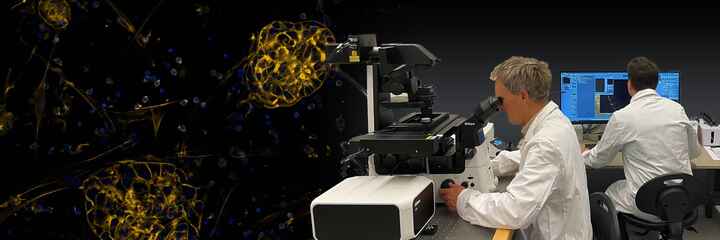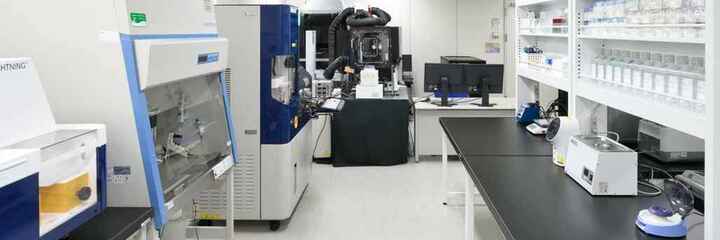News
Microscopic Predator Attack Scene Wins First Place in Annual Nikon Small World in Motion Competition
Dec 9, 2015
See the 2015 Small World in Motion winners
Nikon Instruments Inc. today unveiled the winners of the fifth annual Nikon Small World in Motion Photomicrography Competition, awarding First Place to veteran winner Wim van Egmond of the Micropolitan Museum in The Netherlands. Judges were impressed with the thrilling video van Egmond captured of a ciliate predator devouring its prey.
The microorganisms in this slow-moving attack were scooped out of a backyard pond, as van Egmond hoped to inspire his friend to take more interest in her microscope. Luckily he had his camera ready when he recognized the predator and prey so close together, capturing a real-time recording when the attack began.
“Wildlife is so close to us, yet most of us never look close enough to see it,” said van Egmond. “A pool in your garden is actually a miniature underwater jungle teeming with life. If you want to see the world, your backyard is a great place to start.”
Mr. van Egmond is a former first-place winner of Nikon Small World, Nikon’s long-standing sister competition awarding still photography captured under the microscope. In recent years he has put more time in moving images, thanks to advancing DSLR video capabilities that allow him to capture movement and behavior of microorganisms. “For me, microscopy is about exploring living organisms - so you should see them alive and moving,” said van Egmond.
It is this continued advancement of digital technology that led to the creation of Nikon Small World in Motion five years ago, as scientists and artists were suddenly able to show another dimension to life under the microscope.
“Wim exemplifies the evolution of Small World over the years, as technological advances push our ability to see and discover the world forward, and video takes center stage,” said Eric Flem, Communications Manager, Nikon Instruments. “Beyond still images, video has become a powerful tool for artists and scientists to show the life and movement they see under the microscope every day. This competition serves as a platform to share those discoveries with the world, and hopefully inspire others to pick up a microscope and take a closer look.”
Second Place in the 2015 Nikon Small World in Motion competition went to Danielle Parsons of Wonder Science TV in the United States. Her video provides a glimpse into the roiling gut contents of a termite, including the organisms that help break down wood for their termite hosts. The darkfield microscopy Parsons employed affords dramatic lighting effects and a bold color palate, resulting in an almost cinematic quality of the video. As a science communicator, Parsons was drawn to the unique and intricate collaboration of these species, which have formed their endosymbiotic partnership over evolutionary time.
Gonzalo Avila, a PhD candidate from The University of Auckland, claimed Third Place for his mesmerizing yet horrifying video of a parasitoid wasp larva breaking out of its host and spinning its cocoon. Grim as this parasitism process appears, these wasps play a critical role in controlling the population of the aptly named Gum-Leaf Skeletoniser moth - a pest causing serious damage to Eucalyptus in Australia and New Zealand. While the process of the larva slowly breaking out of its host body can take several hours, Avila’s video is played at 64x speed to show the escape in a matter of skin-crawling seconds.
In addition to First, Second and Third prize winners, Nikon Small World in Motion recognized an additional 15 entries as Honorable Mentions.
The 2015 judging panel includes: Dr. Tim Mitchison of Harvard Medical School, Dr. Hari Shroff of NIBIB, and Ernie Mastroianni of Discover Magazine.
For additional information, please visit www.nikonsmallworld.com, or follow the conversation on Facebook and Twitter @NikonSmallWorld.
NIKON SMALL WORLD IN MOTION WINNERS
First Place
Mr. Wim van Egmond
Micropolitan Museum
Berkel en Rodenrijs, Netherlands
Trachelius ciliate feeding on a Campanella ciliate
250x
Second Place
Miss Danielle Parsons
Wonder Science TV
Los Angeles, United States
Gut contents of a termite, containing hundreds of species of single-celled parabasalid microorganisms (Trichonympha)
Darkfield
40x & 100x
Third Place
Mr. Gonzalo Avila
University of Auckland
Auckland, New Zealand
A parasitoid larva (Cotesia urabae) breaking out of its host (Uraba lugens) and then spinning its cocoon to start pupation
10x
HONORABLE MENTIONS
Dr. Alireza Abbaspourrad
Cornell University
Ithaca, United States
Structural emulsions containing nutrients releasing its contents upon exposure to a simulated gastric fluid
40x
Dr. Paolo Annibale & Enrico Gratton
University of California, Irvine
Irvine, United States
Fluorescently labeled chromatin array (LacI-mCherry: red) and mRNA (MS2-EGFP: green) in U2OS 263 cells following Dox induction (+30′). Discrete Petals of mRNA synthesis are clearly visible moving on the surface of the transgene array
Confocal
60x
Mr. Michael Evers
Massachusetts General Hospital
Boston, United States
A human dermal fibroblast tissue phantom ablated by a 5 ns long laser pulse
3.05x
Mr. Ralph Grimm
Jimboomba, Australia
Rotifer (Lepadella triba) feeding
1000x
Mr. Gerd-A. Günther
Unicellular ciliates (Paramecium caudatum and Frontonia leucas)
Differential Interference Contrast (first sequence) and Polarized Light (second sequence)
300x
Dr. John Hart
University of Colorado Boulder, Department of Atmospheric and Oceanic Sciences
Boulder, United States
Soap film
10x-50x
Dr. Daisuke Kurihara
Nagoya University
Nagoya, Japan
Thale cress plant (Arabidopsis thaliana) embryogenesis
Confocal
30x
Dr. Annie Lu & Dr. Srinivasa Raghavan
University of Maryland
College Park, United States
Chitosan capsules containing platinum reacting with hydrogen peroxide under a glass slide
2x
Ms. Haripriya Mukundarajan, Vivek N. Prakash, Nicolas Harmand & Manu Prakash
Stanford University
Stanford, United States
Cyanobacterium (Oscillatoria princeps) filaments
Brightfield
100x
Dr. Luigia Santella, A. Puppo, JT Chun, G. Gragnaniello & E. Garante
Stazione Zoologica Anton Dohrn
Naples, Italy
Intracellular calcium increase and sperm incorporation following fertilization of a starfish egg
70x60um
Dr. Abigail Tucker & Dr. Marcia Gaete
King's College London
London, United Kingdom
Mouse whisker follicle development in culture
Stereomicroscopy
6.3x
Mr. Wim van Egmond
Micropolitan Museum
Berkel en Rodenrijs, Netherlands
Water flea (Ilyocryptus)
100x
Mr. Wim van Egmond
Micropolitan Museum
Berkel en Rodenrijs, Netherlands
Penicilliumfungi growth, showing hypha, spore production and guttation droplets
10x
Dr. Michael Weber
Max Planck Institute of Molecular Cell Biology and Genetics
Dresden, Germany
Cardiovascular system of a 4 day old zebrafish
20x
Dr. Jing Yan, Jie Zhang & Dr. Steve Granick
Princeton University
Princeton, United States
Janus colloids, micron sized particles that spontaneously move in an AC electric field
40x
ABOUT THE NIKON SMALL WORLD PHOTOMICROGRAPHY COMPETITION
The Nikon Small World Photomicrography Competition is open to anyone with an interest in photography. Participants may submit their images in traditional 35mm format, or upload digital images or videos directly at www.nikonsmallworld.com. For additional information, contact Nikon Small World, Nikon Instruments Inc., 1300 Walt Whitman Road, Melville, NY 11747, USA or phone (631) 547-4200.



